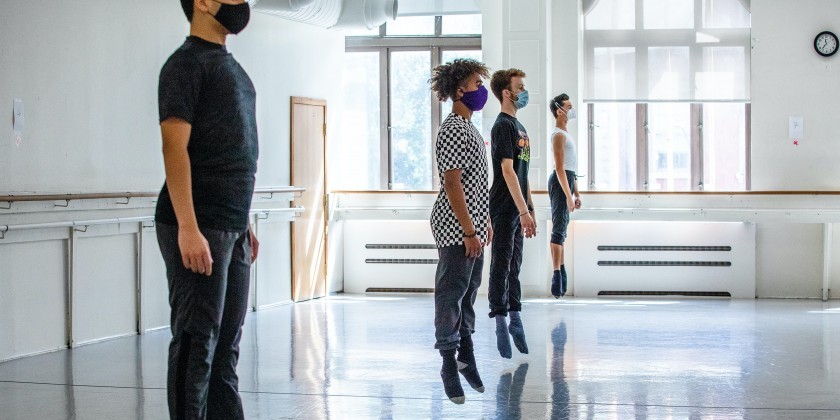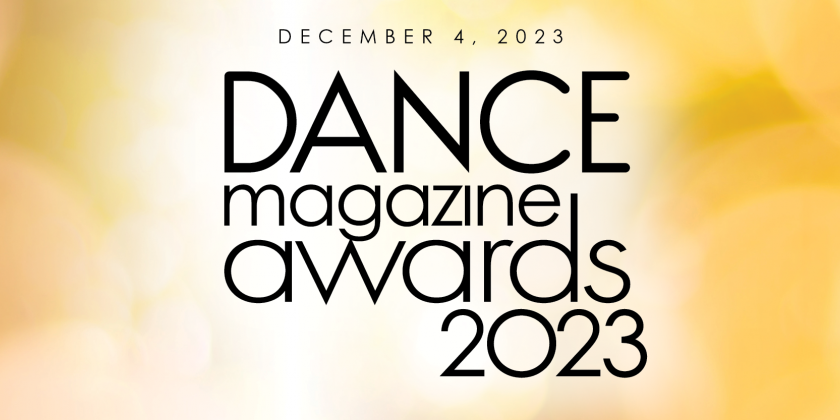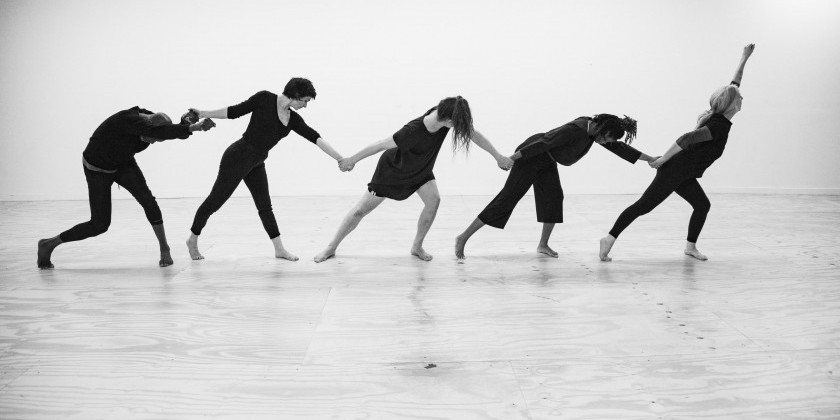Creating Opportunity within Adversity: Reopening University Dance Programs in the Time of Covid-19

With Catherine Cabeen of Marymount Manhattan College, Seán Curran of New York University Tisch School of the Arts, and Alicia Graf Mack of The Juilliard School
On college campuses across the country, fall is a time of bustling activity and cheer. Students move into dorms, gather with friends on quads and in student centers, and meet with study groups in the library. But this semester, things look different. Reopening universities safely amid a global pandemic poses unique and daunting challenges for the performing arts.

Dance relies on space, intimacy, and in-the-moment feedback. “Ballet in a bedroom or between the coffee table and couch isn’t really working,” admits Seán Curran, Chair of the Dance Department at NYU Tisch. “It’s tough on dancers.” As campuses reopen with restrictions, collegiate faculty and staff across New York City have been challenged to create a plan that will maintain their high-quality dance education within guidelines that are antithetical to the art form: social distancing, the absence of touch, and isolation from peer groups.
Multi-faceted Approaches to Reopening
New York University, Marymount Manhattan College, and The Juilliard School have developed approaches contingent on their individual resources and culture. At NYU Tisch Dance, students are in the studio for technique and composition classes only and remote for their academics. Marymount chose an open campus model in which all classes are remote while opening buildings so students can access the dance studios, where they take technique class via Zoom. Juilliard separated their semester into three phases of seven weeks each and, for the first time in its history, offered a summer semester for students to take liberal arts courses online to better concentrate on their field in the fall. “This is a new way of being and doing,” said Curran, “and the students get it.” While conscious of the risk for faculty and students, he also recognizes the need to persevere. “Life is not on pause. We have to keep going.”

For Tisch dance majors, the new normal includes reduced class sizes, shortened instructional time to allow for extra cleaning, weekly or bi-weekly Covid-19 testing for staff and students, and, of course, Zoom meetings. Only eight students, a teacher, and an accompanist are allowed in a studio at a time. Dancers wear masks and work ten feet apart at the barre, twelve feet in center. Classes are offered three days per week rather than five, and students are divided into two cohorts with the option of attending Zoom classes on their non-studio days. There are no traveling phrases across the floor, alternating lines, or crossovers. “Normally you could have a student in Ballet IV and Contemporary II,” Curran explained, “and they would be dancing with totally different groups of people in each class. Now they stay in these small clusters, and if they choose to choreograph, they must use dancers from their own cluster.”
Students at Juilliard operate under a similar model; however, their three-phase system accommodates students flying in from out of state who must complete their fourteen-day quarantine and get tested. In block 1, which ended October 29, all content classes were virtual, and students had access to studios set up with monitors and laptops. Block 2 resembles Tisch’s model, where each cohort is split into groups of eight. One group is instructed by a live teacher while other groups take the same class on Zoom in a different studio. Each day the groups rotate so that the dancers have equal, in-person time with their teacher.
At Marymount, faculty and staff wrestled with the issue of accommodating their students’ varying situations effectively and equitably. “Last spring, some of our students went home to giant suburban homes with basement dance studios, and some to small apartments with unsuitable spaces to dance,” said Associate Professor of Dance, Catherine Cabeen. She appreciates Marymount’s model, which allows for student selection at a time when so much feels out of control. “I think tiny moments of empowerment and choice are important to an overall sense of well-being.”
.jpg)
Performing artists spend their lives in collaboration, solving problems with a mix of creative thinking and flexibility. For Curran, Cabeen, and Alicia Graf Mack, Director of the Dance Division at Juilliard, those skills drove their plans that prepare their incoming students for high-level training. “Over the summer we created different working groups to figure out how to move forward,” said Graf Mack. “Taking a program like Juilliard’s and creating an all-remote opportunity took a huge effort. Many voices were involved. But it is exciting to meet that challenge.”
Concerns and Challenges
Dance is social, not only in its making and doing, but in its sharing and communicating. Naturally the trials of teaching and learning an art form as big and space-driven as dance online means technical and logistical obstacles must be addressed. Yet mental health and dance’s future have been at the forefront of the minds of Curran, Graf Mack, and Cabeen.“Even though we are on Zoom, there is a feeling of isolation, and dancers have to dig deeper into self-assessment and motivation,” said Graf Mack. Cabeen questioned, “How can we deal with depression and anxiety online when it is the digital interface that is causing so much of that depression and anxiety?” As a solution, she begins most of her classes by having students look away from the screen, close their eyes, and ground themselves in their bodies. Graf Mack has been meeting for one-on-one check-ins with each student through the summer and fall, something she plans to continue after the campus returns to normal. Curran is also considering the long-term effects on the industry. “When we get through this, will companies be hiring? How is this period going to change the making and the doing of dance?”

At Tisch, not all the programs are operating in the same way. The theater department is fully remote, and Enmanuel Delarosa, a musical theatre major studying from his home in the Bronx, is also concerned about the future. “[While] training remotely, I really want to dive into the work and be present, but I’m focused on my grandfather in the other room or my brother who is sleeping. If I am rehearsing a scene with curse words, I am worried about my very religious father or my sister in her high school Zoom class on the other side of the living room.” Graf Mack explained, “Performers are so used to feeding off the energy of others. It is difficult when you don’t have your peers to motivate and support you.”
While Zoom has been the saving grace of dancing during this pandemic, it also comes with a significant obstacle — lag time. Precision, clarity, and rhythmic cohesion are important components of training, and they require consistent embodied practice. With time delays, instructors often have difficulty assessing what is actually happening. There is also the problem of visibility. “When I’m on screen, the teachers can’t see my whole body,” Delarosa noted. “I feel I am losing the specificity in my work because I can only focus on one or two things on screen at once. I’m losing focus on my body as a whole.” Other concerns involve communal learning. “When you are in person, you can feel the other dancers around you and be on the same beat,” Cabeen said. “Zoom lag is not just a technical issue — we are losing the sense of communicating across space by holding a collective rhythm in our bodies.” Curran has had to rethink his approach to teaching composition when things like partnering and close group work are not possible. “We are used to the stage being a rectangle. But how can we make a compelling dance for an iPhone or a Zoom square?”

Planning end-of-semester performances has also been a struggle. “Students want the feeling of performing and a way to show their work,” Cabeen said. “Dance is transformative whether it is witnessed or not, so how can we shape their experiences to honor process over product?” Juilliard will conclude their third block in February with a performance filmed in its theater. Four guest choreographers will face the challenge of creating a piece for twenty-four dancers while only working with eight at a time. Tisch dancers will perform in the 180-seat Jack Crystal Theater for an audience of only sixteen. The dancers will also serve as the crew, and each piece performed will be a solo or physically distanced duet or trio. “We are going into this with a plan of rules and regulations,” Curran said, “and imposing strategies to keep students engaged.”
Finding Opportunity within Restriction
For many, dancing can feel less like a choice than a habit. At Juilliard, students have expressed that taking class when nobody can hold them accountable instills a sense of empowerment and a renewed sense of purpose. Cabeen hears her students asking questions about what role dance plays in their lives and how they identify as artists. Delarosa noticed that attending school at home has given his family a greater appreciation of how much effort and discipline it takes to pursue a performance career. “They finally understand what I do and acknowledge it. I no longer feel I have to be secretive about my art.” Graf Mack has been energized by her students. “They are in touch with the world and feel gratitude for the fact that they woke up when so many people didn’t and that they get to dream, think, move, and work.”
The interconnectivity of the internet has helped. Juilliard and Marymount have invited guest lecturers and choreographers from all over the world, no longer limited by travel and lodging expenses. “It has forwarded our ability to create a bridge for our students to the professional world,” Graf Mack said.

While dancing online may hinder the discipline’s communal, social aspects, smaller class sizes allow teachers to give more individualized attention and feedback and develop intimate relationships. For Cabeen, this remote time has allowed her to think more deeply about how to help students retain their sense of embodiment when video submissions have replaced real-time exploration. “In a studio, I can give tasks and have students engage in the process,” she said. “How do I do that in a more and more product-driven world?” She has encouraged students to balance their video work with things like journal entries and collages as a way to process their experiences away from technology.
The Only Way Out Is Through
Social and political uprisings over the spring and summer months opened up conversations about race representation in arts education. Students at Marymount have begun pushing for curriculum changes, and at Juilliard, Graf Mack has talked with students about their responsibilities as artist citizens and activists. “I don’t want to forget about how difficult this summer was in regard to the violence we saw against black and brown bodies and the resurgence of a collective alliance,” Graf Mack said. “It was important for me to voice my stance as an artist so that I could return knowing where I want to lead this division.” At Tisch, one student created a solo about her experiences during a two-week self-quarantine in her dorm room. “It was a cry from the heart,” Curran remarked. “It was a portrait of the times. That is art doing its job.”
“The beautiful thing about working in an ensemble like we do at NYU is I never know what my experiences will be interacting with people or how I will grow from their energy,” Delarosa said. “Right now, I don’t feel energy from my bedroom lamp.” As a solution, he got a job working at Target in the evenings after classes. “This really opened my eyes to what it means to be human and how much we need to connect with others.”

“I am so encouraged by our young people,” Graf Mack commented. “We had dancers in different time zones signing on at 6 a.m. for their 9 a.m. ballet class. You have to be really self-motivated.”
Thinking about post-pandemic education, Curran foresees a radical shift in pedagogical approaches. “For decades, the model for dance training was five days of ballet and contemporary technique, stay moving, cross-train with yoga or go to the gym,” he said. Now, dance education is in a place where students do less, and teachers are learning to sustain their progression over shorter periods of time. “I think dance science and technology will have a whole new relevance going forward,” Curran proposed. “There will also be new ways to monetize dance: you can teach a Zoom class, and 400 people from all over the world can attend. There will be new opportunities.”














